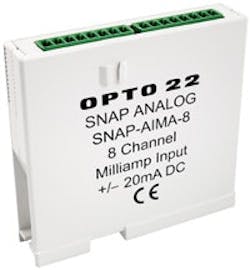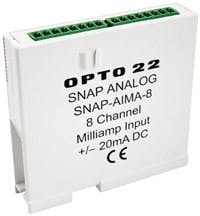More Channels in a Smaller Space
When implementing I/O solutions, the number of channels and racks can have a major impact, especially in projects with stringent space limitations.
Previously, customers with applications with high I/O point counts would need to deploy multiple racks of the four-channel versions of modules, says Bob Kouroubacalis, senior hardware engineer at Opto 22.
Alternatively, they could use the 32-channel versions, which require use of a separate breakout board. Both of these options could prove problematic for some machine builders and other customers.
The introduction of its new analog current, analog voltage, and temperature input modules is part of an Opto 22 response to the space dilemma. Snap-AIMA-8, Snap-AIV-8, and Snap-AICTD-8 are designed for use with Opto 22s flagship Snap PAC systems to connect to and communicate with analog sensors, devices, and equipment in industrial applications involving process control, monitoring, and acquisition of temperature, pressure, flow, and other analog values.
For more information call 800/321-6786, e-mail [email protected], or browse to www.opto22.com.
An eight-channel version provides higher-density I/O without extra racks, and, in an architecture where field termination to the module is desired, no breakout board is required. Using the new modules can decrease the per-point cost of applications, while also greatly reducing the required panel space.
The new eight-channel modules add to the current line of 16 and 32-channel high-density I/O, which are designed to provide consolidation and space savings. The new versions are created to offer increased density in configurations that terminate at the module.
A single rack of the eight-channel modules offers up to 128 I/O points for larger applications involving process values. These types of applications include thermoforming, curing, refining, PID loop control, molding machines, and various types of tests stands.
Unlike Opto 22s 32-channel high-density analog I/O modules, the new eight-channel modules do not require purchase and configuration of an external breakout board for connection to field devices. Instead, wiring is accomplished via eight-pin connections on two pluggable terminal strips on the top of the module.
Snap-AIMA-8 module provides eight channels of -20 mA to +20 mA analog current input and can be scaled for use anywhere within this operating range. Its transformer isolated and, like all Snap analog modules, optically isolated from the equipment and devices it connects to, as well as from other modules that may reside on a shared I/O rack. The 4-20 mA and 0-10 V are among the most common analog input signals, says Kouroubacalis.
Snap-AIV-8 provides eight channels of analog voltage input. Each channel can be configured for ±5 Vdc or ±10V dc operation or scaled for use anywhere within these operating ranges. Snap-AIV-32 is also transformer isolated.
Snap-AICTD-8 was designed in direct response to Opto 22 customer needs, and provides eight channels of analog temperature input from standard integrated circuit temperature devices. Although the eight channels are not isolated from each other, the module is transformer isolated. Wiring to field devices is accomplished via eight-pin connections on two pluggable terminal strips on the top of the module.


